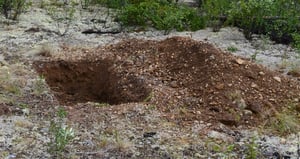.jpg?width=300&name=FY23-Yukon-CS-Hero-v2%20(1).jpg)
Direct burial posthole sites in Yukon yield excellent results
https://www2.uottawa.ca/en
PROJECT INFORMATION
A new broadband seismograph network for passive seismic imaging of earth structures has been installed in the Yukon using a new Posthole installation method that is now yielding excellent results.
The University of Ottawa turned to Nanometrics for a turnkey real-time seismic network consisting of seven Libra II stations as part of a five-year study to better understand seismicity and crustal behaviour in the Mackenzie Mountains and River Basin region of the Yukon. This area is known to be the most seismically active in Canada. Pascal Audet, Assistant Professor, Faculty of Science, Department of Earth Sciences, University of Ottawa, will use the seismic data to determine earthquake patterns and map faults in Canada’s northwest. He explains that, “despite being one of the most seismically active regions in Canada, this area remains very poorly studied due to a lack of seismic station coverage. This new network bridges that gap and allows us to determine the location and magnitude of small earthquakes very accurately and estimate seismic hazard in this area.”
CHALLENGES
Site selection and budget were key considerations when designing and installing this seismograph network, which was challenging given the extreme northern climate with brutally cold winters.
SOLUTION
Despite the low power of the Libra II VSAT system (~5 Watts), it was decided to use mains power for 5 stations due to low solar insolation in the region and the uncertainty associated with snow depth and overall accumulation. The remaining 2 stations would be solar powered. The five stations were connected to AC power on municipal property and using Trillium 120 Posthole seismometers mitigated the anticipated cultural noise from these sites. The 2 remaining solar powered sites were placed in very remote locations near airfields for better access.
The Trillium 120 Posthole broadband seismometer was the sensor of choice for all 7 sites because it is ideally suited to provide quality data with minimal site preparation. It has been demonstrated with other installations that it is possible to reduce site noise below that of the instrument and at the same time keep assets secure with a minimized station footprint. Furthermore, a near surface burial in sub-arctic and temperate regions also easily eliminates tilt noise induced through the freeze/thaw cycles. When installed on competent material the sensor performance is excellent as there are inherent noise field benefits associated with installing a seismometer in a down-hole environment that are not available to vault instruments. Cultural noise is reduced and horizontal noise, in particular at longer periods, is significantly suppressed in down-hole environments. While this is somewhat depth and lithology dependent, as this deployment has shown, excellent results are possible even with simple near-surface direct burial installations.
The Nanometrics field engineering crew used a new hand dug direct burial Posthole installation method to install the seven Trillium 120 Postholes in the above-mentioned remote locations. By using the earth as a natural vault, this method reduces the time and cost usually incurred when building a surface vault which requires labour intensive infrastructure. There are distinct advantages in directly burying the sensor because it is insulated and when installed in competent material, it is more closely coupled to the ground. In our experience, this method always yields better results than a surface vault at the same location, as the posthole sensor is more stable.
RESULTS
The installation was completed one week ahead of University of Ottawa’s scheduled deadline, and took 16 days, despite the fact that inter-station distances were significant. “I drove a total of >4500 km on sometimes very difficult dirt roads in that trip,” explained Pascal Audet. Now that the stations are fully operational, the much-anticipated real-time data from these hand dug direct burial postholes are yielding excellent results. The results are even more exemplary, given that 5 of the 7 stations were placed in culturally noisy areas because the stations are connected to municipal AC power sources.
These outstanding results are also being evidenced in direct burial postholes in other networks around the world. For example, in YE.PIC3, Passcal Instrumentation Center station at Poker Flat, Alaska, USA, the SQLX PDF plots demonstrates that this Trillium 120 Posthole sensor approaches the NLNM on quiet days; a level of horizontal performance typically achieved only in deep boreholes. It is also worth noting in the data plots for both stations how the Z channel is close to the NLNM, with the horizontal performance better than a typical surface vault. These plots demonstrate world-class performance from a very simple and low cost installation technique.
The stations in this real-time network transmit data to the GeoScience BC hub in Sidney, British Columbia and then to University of Ottawa. This network will complement the CNSN (Canadian National Seismograph Network) and these 7 new stations will help to strengthen the CNSN by adding station density and filling a gap in the station data. Audet will visit the stations once a year for the remainder of the study.

“Doing fieldwork in the Canadian northwest can be logistically very difficult, and variable field conditions require a robust and versatile product. To remain on budget, this operation also required minimizing time spent in the field without compromising on the quality of the installations. The direct burial of posthole instruments was certainly the best solution in terms of saving time in the field and delivering extremely high-quality data.”
